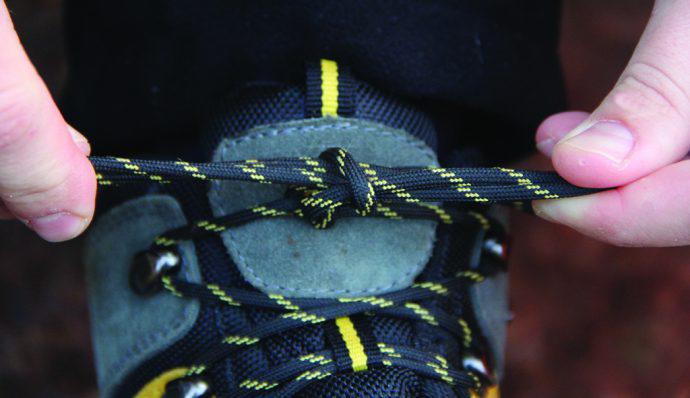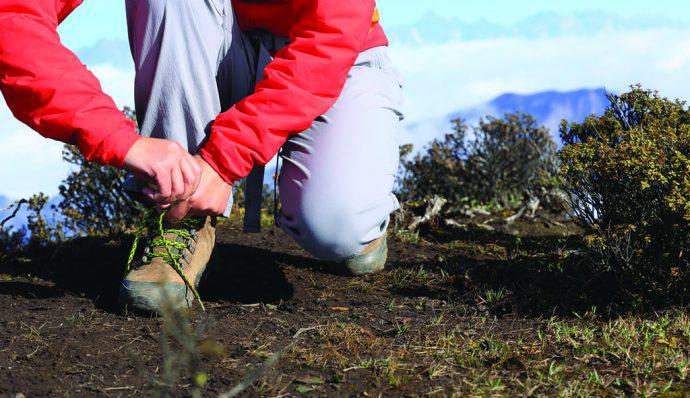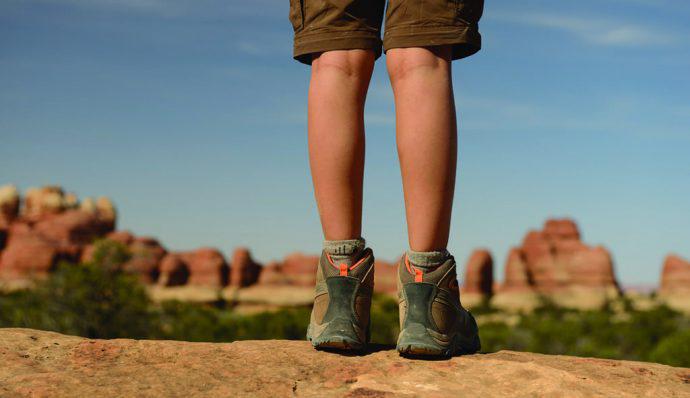The importance of getting the right hiking boot fit cannot be overstated. One quarter of the bones in your body are in your feet, and the soles have more nerve endings per square centimeter than any other part of your body. On a typical day of walking—never mind during a hike—your feet withstand hundreds of tons of accumulated force. You can see why adding tricky terrain, weather changes, and long periods of walking would require the best possible hiking boot. If you’re reading this article, you probably already realize that finding the right fit is important. It’s also important to realize that not all boots are created equal. You might be used to finding a shoe you like in a store or online, finding your size, and assuming you’re all set, but when you’re adventuring in the great outdoors, your feet deserve more, if only to avoid unnecessary pain. But, this doesn’t have to be an overwhelming experience! This guide will help you find exactly what your feet are looking for and need.
The basics of hiking boot shopping
 There are a few more steps that go into choosing and buying hiking boots than there are for other kinds of shoes. For instance, you should try to buy from a store rather than an online retailer, since you’ll need to be sized. Or, at the very least, try on a shoe in stores to find how it fits before purchasing online. Once in the store, you should ask to be sized with a Brannock device. This measures the length and the width of your foot to get the ultimate fit. You should also make sure to buy from an outdoor shop that specializes in hiking and backpacking products. This will ensure that you don’t purchase the wrong type of boot, like a hunting boot or something that’s basically a better version of a street shoe. These shoes can look the part, but they won’t provide the right fit or endurance for a hike. Bottom line? Visiting a store is important. To get the correct hiking boot fit, it’s also important to shop for boots in the afternoon or evening. Your feet swell throughout the day, so your shoe size in the morning will be different than your size later on. This will be important on the trail, since you’ll want your boots to be comfortable all day, not just when you begin hiking. When you go in to get fitted, make sure that you bring your hiking socks with you. Socks for everyday wear are generally thinner and are constructed differently than hiking socks, so you want to make sure that the boot and sock are a good match. Overall, you’re looking for a boot that doesn’t slip in the heel and has plenty of toe-room in the front. You’ll usually end up with a boot that’s a bit longer than your standard shoes to ensure that your toes won’t get cramped when you’re going downhill with a heavy pack.
There are a few more steps that go into choosing and buying hiking boots than there are for other kinds of shoes. For instance, you should try to buy from a store rather than an online retailer, since you’ll need to be sized. Or, at the very least, try on a shoe in stores to find how it fits before purchasing online. Once in the store, you should ask to be sized with a Brannock device. This measures the length and the width of your foot to get the ultimate fit. You should also make sure to buy from an outdoor shop that specializes in hiking and backpacking products. This will ensure that you don’t purchase the wrong type of boot, like a hunting boot or something that’s basically a better version of a street shoe. These shoes can look the part, but they won’t provide the right fit or endurance for a hike. Bottom line? Visiting a store is important. To get the correct hiking boot fit, it’s also important to shop for boots in the afternoon or evening. Your feet swell throughout the day, so your shoe size in the morning will be different than your size later on. This will be important on the trail, since you’ll want your boots to be comfortable all day, not just when you begin hiking. When you go in to get fitted, make sure that you bring your hiking socks with you. Socks for everyday wear are generally thinner and are constructed differently than hiking socks, so you want to make sure that the boot and sock are a good match. Overall, you’re looking for a boot that doesn’t slip in the heel and has plenty of toe-room in the front. You’ll usually end up with a boot that’s a bit longer than your standard shoes to ensure that your toes won’t get cramped when you’re going downhill with a heavy pack.
What to expect from your hiking boot
There are a few things to keep in mind when examining a hiking boot.
- Make sure that the bottom of the boot feels solid, and looks firm and thick. This will help absorb shock and cushion your feet from sticks, stones, and general trail unevenness. If you can indent the sole of the shoe with your thumb, it’s not sturdy enough for the trail.
- The sides of your boots should have extra padding to protect you from anything that could dig into them. Some boots even have welts —pieces of leather between the sole and the fabric of the rest of the boot—that rise up a half inch or more from the sole to provide even more protection. Either way, the sides of the boot should feel sturdy.
- The arch of the boot should feel supportive to your foot. If it doesn’t, try a different boot or adding inserts.
- Your boots should be heavy enough to properly support your feet on the trail. If they’re too light, they might not be able to cushion your feet while you’re carrying a backpack.
Tests to perform in the stores
Once you’ve found a pair of hiking boots to try on, there are a number of tests to do to ensure the fit is right.
- After you’ve put on the boot but before you’ve laced your hiking boots, move your foot as far forward as possible. If it’s the right size, you should be able to put your index finger inside the boot behind your ankle. This makes sure that you have enough room for your toes when going downhill.
- Then, take off your sock and try on the boots with bare feet. Feel around for any tight areas that could be difficult to sense through socks. Pay special attention to how narrow the boot feels through the ball of your foot and on either side of your arches. If the boots pass that test, then put your socks back on and feel again for tight spots or looseness. If it doesn’t fit well, pick another boot.
- Walk around in the boots. Make sure that your toes don’t feel jammed and that the tops of your toes feel comfortable where the boot creases. If your heel slips and slides against the back of the boot, that’s a sign to find a different boot.
- If walking feels good, ask to try walking on a slant board, an angled wooden frame that can simulate walking downhill. If you can walk down the incline without your toes feeling jammed, you’ve got a winning pair of hiking boots.
- Last, take your boots over to the pack department and try on something that approximates what you’ll be carrying on your hike. If you can handle the weight and still feel comfortable in your boots, congratulations! You’ve found a winner!
Hiking boot fit for women
 Women buying hiking boots have a few extra things to pay attention to when considering fit. Because women have about four times more problems with their feet than men do—largely due to wearing heels and pointy-toed shoes— finding the right fit is extra important. There are also some important differences between men’s and women’s feet that you may not realize:
Women buying hiking boots have a few extra things to pay attention to when considering fit. Because women have about four times more problems with their feet than men do—largely due to wearing heels and pointy-toed shoes— finding the right fit is extra important. There are also some important differences between men’s and women’s feet that you may not realize:
- Women have thicker ankles and narrower heels, which leads to differences in the back of the boot.
- They also have smaller toes, which affects how much room they need in the front of the boot.
- Women’s arches are higher, meaning that they require more support from a boot.
On top of these differences, women generally wear tighter shoes than men do. Keep this in mind when shopping, ladies! If you buy boots that are too small, the fabric will stretch and the sole won’t be able to support the whole of your foot, causing stress on your entire body, including bruises and blisters. Being mindful of this when doing fit tests should ensure you end up with a great boot.
Hiking boot fit for children
 Buying hiking boots for children can be especially difficult. Kids’ feet get bigger as they age, but they also change shape, meaning that fit is especially important. Before age 6 , kids have relatively flat feet since they’re still developing arches, but even afterward, the shape of their feet continues to develop until age 13-15. Unfortunately for parents, this means that if you’re going to be hiking with your kids, you’ll have to buy different boots as they age to make sure they won’t hurt themselves, but there are some workarounds so that you don’t break the bank. Sneakers can work for young children or if you’re hiking short distances on flat trails, especially since kids’ shoes should be lightweight and low-cut since they can’t hike as many miles as adults. However, once you’re faced with rocky ground, protruding roots or slippery surfaces, a proper pair of hiking boots will save your child from unnecessary injury, and as they age, you can upgrade your kids to heavier and sturdier boots as necessary. Keep in mind that any kid who’s carrying an overnight pack should be wearing a boot that extends over the ankle. Long hikes provide ample opportunity for slipping and twisting an ankle and these types of boots will protect them. Boots with less ankle protection will be OK for less intense hikes, but parents should always invest in durable materials. No matter what your boot needs are, you can be sure that you’ll be able to find them. You just have to know the steps to take (no pun intended)!
Buying hiking boots for children can be especially difficult. Kids’ feet get bigger as they age, but they also change shape, meaning that fit is especially important. Before age 6 , kids have relatively flat feet since they’re still developing arches, but even afterward, the shape of their feet continues to develop until age 13-15. Unfortunately for parents, this means that if you’re going to be hiking with your kids, you’ll have to buy different boots as they age to make sure they won’t hurt themselves, but there are some workarounds so that you don’t break the bank. Sneakers can work for young children or if you’re hiking short distances on flat trails, especially since kids’ shoes should be lightweight and low-cut since they can’t hike as many miles as adults. However, once you’re faced with rocky ground, protruding roots or slippery surfaces, a proper pair of hiking boots will save your child from unnecessary injury, and as they age, you can upgrade your kids to heavier and sturdier boots as necessary. Keep in mind that any kid who’s carrying an overnight pack should be wearing a boot that extends over the ankle. Long hikes provide ample opportunity for slipping and twisting an ankle and these types of boots will protect them. Boots with less ankle protection will be OK for less intense hikes, but parents should always invest in durable materials. No matter what your boot needs are, you can be sure that you’ll be able to find them. You just have to know the steps to take (no pun intended)!
You may also enjoy
View all articles in this category
Hiking and Backpacking Boots and Shoes
Find Your Fit: How To Choose Hiking Boots
You've got your eyes set on the perfect hike. But are you set on the best pair of hiking boots for the job?

Hiking and Backpacking Boots and Shoes
The Ultimate Hiking Boot Glossary
Are you a hiker or backpacker looking to deepen your understanding of hiking boot terminology? Check out our glossary.
Hiking and Backpacking Boots and Shoes
The Art of Acclimation: How to Break in Hiking Boots
How to break in hiking boots? It’s kind of like prepping to climb Everest or K2.


